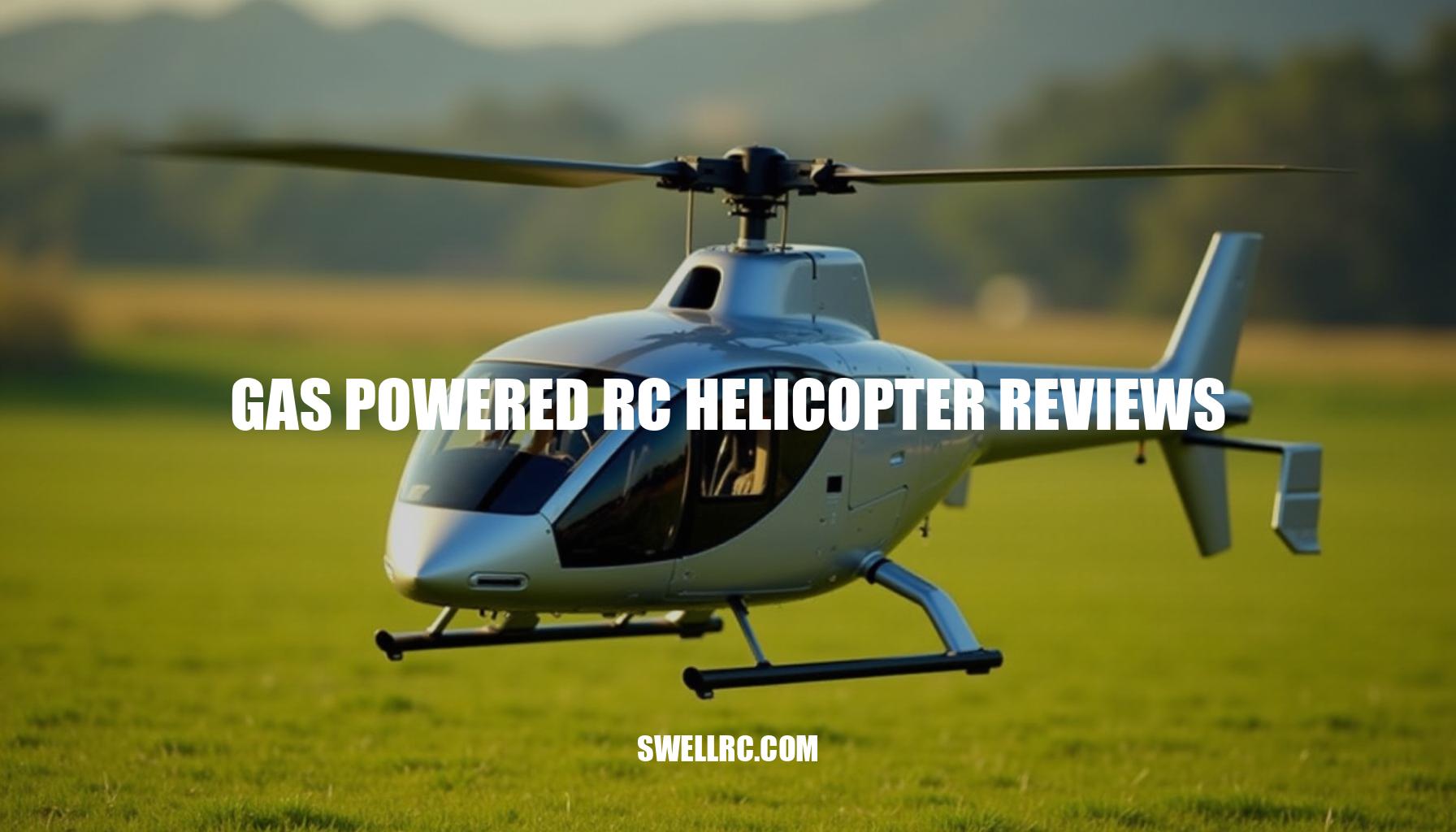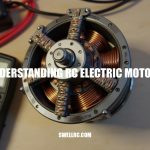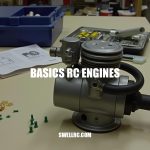Gas Powered RC Helicopter Reviews: Expert Insights and Buyer’s Guide
After countless hours of testing, tuning, and flying everything from micro trainers to big-scale birds, I’ve fallen back in love with gas powered RC helicopters. They don’t just fly; they thrum with life. The carb burble at idle, the rotor disc loading you can feel in your thumbs, and the way they hold in wind—there’s a visceral, mechanical satisfaction that electric models rarely match.
The RC flying hobby has evolved fast, but gas and nitro RC helicopters still stand out for endurance, realism, and that addictive sound. Whether you’re browsing gas powered RC helicopter reviews or comparing gas vs electric RC helicopter models, there’s something uniquely rewarding about mastering a radio-controlled helicopter with a roaring engine. If you’re new to this corner of the hobby, this overview is a great primer: https://www.swellrc.com/gas-powered-remote-control-helicopter/.
In this guide, I’ll share hands-on reviews, what to buy (and avoid), maintenance routines that actually work, and when it makes sense to step up to turbine-grade machines, ensuring your journey into nitro RC helicopter adventures is smooth and thrilling.
What Makes Gas Powered RC Helicopters So Special?
Power and realism meet in a uniquely satisfying way when you choose a gas RC helicopter. Here’s why I keep reaching for my gasser when the weather is good:
- Power delivery and torque: Gas and nitro engines maintain punch deeper into the flight, with less voltage sag compared to electrics. You’ll notice more consistent headspeed in big, loaded maneuvers, making RC helicopter flight time more exhilarating.
- Endurance: Typical sport setups get 18–35 minutes on a tank; careful tuning and larger airframes can stretch to 40+ minutes. Most comparable electrics run 5–12 minutes, highlighting the advantage of gas vs electric RC helicopter endurance.
- Authentic feel: Real throttles, mixture needles, clutch engagement, and a proper rotor spool-up. This immersive experience teaches you more about the RC helicopter engine and overall mechanics.
- Mechanical depth: You learn engines, linkages, and balance in a way that makes you a better pilot and builder of radio-controlled helicopters.
For those new to the hobby, here are some beginner-friendly definitions to help you better understand the nitty-gritty:
- Rotor head: The assembly that connects blades to the main shaft and controls blade pitch.
- Engine displacement: The engine’s cylinder volume (e.g., 0.50–0.90 cu in nitro) reflecting power potential.
- Nitro mix: A blend of methanol, nitromethane, and oil used in glow engines, commonly 15–30% nitro.
If you dabble in fixed-wing aircraft, check out this comparison to align expectations: Best Gas-Powered RC Planes.
| Aspect | Gas RC Helicopter | Electric RC Helicopter |
|---|---|---|
| Flight Time | 18–45 minutes | 5–12 minutes |
| Weight | Heavier | Lighter |
| Maintenance | Higher (engine tuning, vibration checks) | Lower |
| Upfront Cost | Higher (airframe + engine + pipe + support tools) | Varies |
| Operating Cost | Moderate (fuel) | Moderate (battery packs wear over cycles) |
| Noise | Louder | Quieter |
| Learning Curve | Steeper | Friendlier |
Choosing between a nitro RC helicopter and an electric model depends largely on what experience you seek. Gas-powered heli enthusiasts value longer RC helicopter flight time and a hands-on connection to their RC helicopter engine, while electric fans lean towards convenience and low maintenance. Understanding the nuances of gas vs electric RC helicopter technologies will help you find the perfect fit in the world of radio-controlled helicopters.
Top Gas Powered RC Helicopter Reviews and Hands-On Insights
In my journey with gas powered RC helicopter reviews, I often rely on electric platforms to build foundational skills and evaluate handling before moving on to larger gas-scale builds. The Gartt 450L serves as my baseline trainer, ideal for intermediate pilots honing collective management. This 450-class model scores well in power (7.5/10) and design (8.0/10), making it an excellent skills gym with affordable parts, as highlighted in the Gartt 450L review.
For those seeking advanced scale realism, the Roban RC heli shines with a powerful setup-dependent rating of 8.5 and an impressive design score of 9.5. Its roomy mechanics bays and gas-friendly size make it a top pick among gas powered RC helicopter enthusiasts, despite increased weight and complexity (Roban RC heli). Beginners should consider the Wltoys V950 helicopter as a budget brushless trainer; rated 6.5 in power and 7.5 in ease of use, it’s cheap, stable, and perfect for orientation practice (Wltoys V950 helicopter). For absolute novices, the Syma S107G micro coaxial offers excellent ease of use (9.0/10), robustness, and affordability, making it a dependable indoor orientation trainer (Syma S107G).
Finally, the Hero RC H911 provides a smooth transition into outdoor hovering and light circuits with forgiving handling and good value (Hero RC H911).
Here’s a comparative overview:
| Model | Power (out of 10) | Ease of Use | Design | Value | Best For |
|---|---|---|---|---|---|
| Gartt 450L | 7.5 | 6.5 | 8.0 | 8.5 | Intermediate collective management |
| Roban RC heli | 8.5 | 6.5 | 9.5 | 8.0 | Advanced scale realism, gas builds |
| Wltoys V950 | 6.5 | 7.5 | 6.5 | 8.0 | Beginners progressing beyond toys |
| Syma S107G | 2.0 | 9.0 | 6.0 | 8.0 | Absolute beginners, indoor practice |
| Hero RC H911 | 4.5 | 7.0 | 6.5 | 8.5 | Outdoor hovering, light circuits |
By using these electric helicopters—like the Gartt 450L and Roban RC heli—I develop muscle memory, fine-tune flybarless (FBL) gains, and validate mechanical setups cheaply. This strategy smoothly scales up to nitro and gasoline platforms, where endurance and the authentic feel of gas powered RC helicopters truly come into play.
Choosing the Right Gas Powered RC Helicopter (Buyer’s Guide)
Matching your skill level, space, and budget to the right gas RC helicopter saves both money and frustration. When selecting the best aircraft, consider these key factors:
- Engine size: Typically, a 0.50–0.90 nitro or 15–26cc gasoline RC helicopter engine is common. Larger displacement provides more torque, which is essential for scale rotors and longer blades.
- Rotor system: Flybarless (FBL) units dominate the market due to their efficiency and tuning flexibility, while scale heads prioritize realism at the cost of agility.
- Electronics: Reliable FBL units with governor support are crucial, alongside high-voltage servos and radios featuring fine exponential and curve control.
- Airframe materials: Carbon fiber frames and metal heads combat vibration effectively, a significant advantage for gasser setups that are prone to engine vibes.
- Fuel efficiency and tank size: Aim for flight durations between 18–30 minutes during sport flying, keeping a comfortable fuel reserve.
- Parts ecosystem: Choosing platforms with abundant spare parts and a strong community support network simplifies maintenance and repairs.
For those new to the hobby, avoiding common beginner mistakes is important when considering the gas vs electric RC helicopter debate. Key pitfalls include:
- Starting too big; a 700+ class gasser can be intimidating. The best RC helicopter for beginners usually starts with smaller electric models (450–500 size) to build flying habits before stepping up to mild 600–700 nitro engines.
- Skipping the governor, which helps maintain consistent headspeed and simplifies tuning.
- Over-tightening blades and linkages, leading to vibrations and overheating.
- Underestimating the necessity of essential tools such as a tachometer, temperature gun, fuel filters, threadlock, and a robust starter unit.
When assessing your needs, use this quick checklist:
| Assessment Criteria | Description |
|---|---|
| Skill Level | Be honest about your ability before selecting a model. |
| Field Size & Noise Limits | Confirm the flying environment supports your heli’s size and sound. |
| Spare Parts & Budget | Account for expenses related to crashes and maintenance. |
| Engine Tuning Comfort | Do you have a mentor or experience tuning gas engines? |
| FBL Unit | Choose a unit with proven settings tailored for gas-powered helicopters. |
If you already have experience maintaining surface engines, transitioning to a gas powered RC helicopter might feel familiar. Many of the skills transfer from models such as gas-powered RC cars, as seen on platforms like SwellRC.
Finally, consider these recommended picks based on your flying goals:
- Best for beginners: Start with electric 450–500 size helis to build foundational skills, then advance to mild 600–700 nitro models.
- Best for realism: Large scale airframes such as Roban models paired with smooth governor tuning and modest head speeds create a realistic flying experience.
- Best flight duration: Efficient gasser setups with conservative pitch, head speeds, and properly tuned mixtures maximize flight time.
Balancing the advantages of a gas powered RC helicopter cost against performance and maintenance ensures you select the optimal machine that matches your flying aspirations.
Maintenance, Tuning, and Longevity Tips
Consistent gas RC helicopter maintenance is key for longevity and performance. To know how to maintain a gas RC helicopter engine, start by managing fuel and storage properly. Always use fresh fuel and clean filters, and replace clunk lines regularly.
After your last flight of the day, if practical, run the engine dry and oil all moving parts to prevent wear. Store your RC helicopter engine with the blades supported to avoid bending or grip wear.
Tuning and cooling are critical aspects of nitro RC helicopter care. Set your carb base needle per the manual instructions, then slightly richen during break-in.
Slowly lean the mixture while monitoring temperatures and smoke to find the ideal balance. Adjust the governor to maintain a headspeed that keeps the engine within its torque band, avoiding heat soak. Ensure that cooling baffling and fan shrouds are intact because hot cabins can severely damage engines.
An inspection routine every 5 to 10 flights helps catch issues early:
- Check clutch liner, fan hub, and engine mounts for wear and runout.
- Review FBL logs for vibration levels, and track or balance blades as needed.
- Retorque frame screws and tail case, and reapply threadlock where necessary.
Common problems can often be fixed quickly:
- If the engine runs hot or power fades, richen the high needle 1–2 clicks and check for air leaks.
- For tail wag, lower gain or inspect tail hub balance and check for linkage slop.
- Hovering vibrations warrant checking the main shaft or spindle, blade balance, and engine isolation grommets.
- Hard starts require verifying glow plug or ignition, fuel priming, and idle mixture settings.
For more RC helicopter engine tuning tips, reliable how-tos, and parts sources, visit trusted RC helicopter websites like SwellRC.
Keep a field kit stocked with a tachometer, temperature gun, threadlock, digital pitch gauge, spare bearings, and fuel line to ensure smooth operation. Following this routine keeps my gas RC helicopter engines running smoothly for seasons, not just weeks.
Exploring Advanced Options – Turbine and Hybrid RC Helicopters
When you’re ready for the pinnacle of realism, turbine RC helicopters truly change the game. These machines spool up just like full-scale turbines, delivering smooth, continuous power accompanied by incredible sound effects that enhance the immersive flight experience. While they come with higher costs and stricter safety margins, the meticulous preflight procedures are part of what makes them so rewarding for serious hobbyists.
- Power and fuel: Small kerosene or Jet-A turbines provide substantial shaft power through a reduction gearbox, offering exceptionally smooth performance with minimal vibration—perfect for enthusiasts seeking realistic RC helicopters that fly like real ones.
- Maintenance: These turbine RC helicopters are more checklist-driven than wrench-heavy. Routine care involves monitoring filters, bearings, and ensuring careful starts, with strict fuel hygiene being essential for reliability and longevity.
- Performance: When paired with big-scale airframes, large gas RC helicopters powered by turbines feel remarkably planted in the air. Typical flight times range from 8 to 15 minutes, depending on tank capacity and throttle management.
- Cost: Expect to invest between $2,500 to well over $10,000 for a complete setup including airframe, turbine, and electronics. These high-end options represent the cutting edge in the market and cater to dedicated pilots.
Curious about what’s available on the market? Check out the latest turbine RC helicopter for sale to explore some top-tier models. Personally, the first time I hovered a turbine, the spool-up alone sold me—the presence in the air is unlike anything else in the hobby.
Conclusion – The Future of Gas Powered RC Flight
Gas-powered RC helicopters aren’t just nostalgia—they’re a masterclass in aeromechanics and piloting. In my testing, gas RC helicopters consistently win on endurance, immersion, and long-term satisfaction, especially when compared to their electric counterparts. While electrics excel in convenience and are ideal for beginners, the robust performance of gassers shines through in extended flights and realistic mechanical engagement.
From standard trainer benchmarks like the 450-class platforms to impressive scale showpieces such as the Roban RC heli builds, there’s truly a path for every enthusiast in the RC flying hobby. These machines offer a unique blend of craftsmanship and flight that can’t be replicated by simpler models, rewarding pilots who are eager to tune, listen, and feel their rotor in the air.
If today’s deep dive into gas-powered helicopters sparked your curiosity, I recommend revisiting the foundational guides and gas powered RC helicopter reviews we’ve discussed. These resources can help you consider how to progress from a trainer model into your first nitro or gasoline-powered machine, ensuring you get the best experience possible.
| Feature | Gas-Powered RC Helicopter | Electric RC Helicopter |
|---|---|---|
| Flight Time | Longer (RC helicopter flight time) | Shorter |
| Maintenance | Higher (tuning and fuel management) | Lower (battery charging) |
| Learning Curve | Steeper | Gentler |
| Realism | Superior immersion and mechanical feel | Less authentic experience |
That blend of technical mastery and the joy of flight is why gas RC helicopters like those from Roban continue to captivate pilots. The magic truly lives at that intersection of craftsmanship and air, and it’s why I keep coming back to these gassers. They will always have a proud place in our RC flying hobby.
Frequently Asked Questions
- Are gas powered RC helicopters better than electric ones?
They’re better for endurance, realism, and mechanical engagement, while electrics are easier, quieter, and cheaper to operate. I use electrics to train and gassers for long, immersive flights. The best choice depends on your goals, budget, and noise limits. - How long can a gas powered RC helicopter fly on a full tank?
With solid tuning and moderate headspeed, expect 18–35 minutes. Larger, efficient setups can push 40+ minutes; aggressive 3D or hot weather may reduce duration. - What is the most reliable gas powered RC helicopter brand?
Look for brands with strong parts ecosystems and community support. Historically, Align, Hirobo, Thunder Tiger, and quality scale airframes like Roban (paired with proven engines) have earned trust for reliability. - How hard is it to maintain a gas powered RC helicopter?
Harder than electric but very manageable with a routine. Plan on post-flight checks, periodic needle tweaks, vibration inspections, and scheduled bearing/clutch service. A tach and temp gun make it straightforward. - Which gas powered RC helicopter is best for advanced pilots?
Large 600–800 class airframes with robust gasser or nitro power, a good governor, and quality FBL units. Scale airframes (e.g., Roban) or 3D-focused nitro/gas conversions shine for experienced pilots. - How much does it cost to build your own gas powered RC helicopter?
A capable setup typically totals $1,200–$3,000+ for airframe, engine, pipe, electronics, and support gear. Large scale or turbine builds can run well beyond $5,000.



